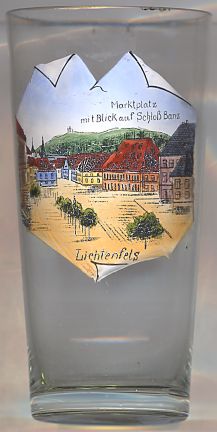

|
| DEUTSCHLAND | GERMANY |
| Bundesland: Freistaat Bayern | Bavaria |
| Regierungsbezirk: Oberfranken | |
| Landkreis: Lichtenfels |
 Lichtenfels is situated at an elevation of 271 m on the river Main in the Upper Franconia region of Bavaria.
Lichtenfels is the administrative seat of the district of the same name and has a population of about 21,300 (2005).
Lichtenfels is situated at an elevation of 271 m on the river Main in the Upper Franconia region of Bavaria.
Lichtenfels is the administrative seat of the district of the same name and has a population of about 21,300 (2005).
The area had already been inhabited since the Palaeolithic period. Lichtenfels was already the name of a stronghold that had been built above the valley around AD 1000 and which was destroyed in 1525 during the Peasants' War. The castle probably was founded by the counts of Schweinfurt. In 1142 the domains were handed over to the bishopric of Bamberg. The deed of donation is the oldest known document mentioneing the name Lichtenfels. However, the donation was contested by the Dukes of Andechs-Meranien and it took until 1260 that the bishops of Bamberg obtained the full sovereignty over Lichtenfels. The first fortification of the market town were built in 1231. It is possible that Lichtenfels already at that time was granted the status of a town. The sovereignty of the bishops of Bamberg ended in 1802 when Lichtenfels was occupied by French troops. After the Napoleonic wars, Lichtenfels was finally incorporated into the kingdom of Bavaria. The foritifications were finally demolished in 1844/1845 when the railroad was built. During the second half of the 19th century Lichtenfels became a well-known centre of basket makers. Between 1929 and 1978 the neighbouring communities of Burgberg, Oberwallenstadt, Weingarten, Mistelfeld, Klosterlangheim, Kösten, Stetten, Mönchkröttendorf, Buch am Forst, Isling, Köttel, Roth, Rothmannthal, Trieb, Lahm, Oberlangheim, Seubelsdorf, Schney and Reundorf were incorporated into the municipality of Lichtenfels.
The  town hall [center] on the market square is already the third town hall
of Lichtenfels. The first was probably built around 1400, and the second was demolished in 1740. The present town hall
was built by Justus Heinrich Dientzenhofer and was completed in 1475.
town hall [center] on the market square is already the third town hall
of Lichtenfels. The first was probably built around 1400, and the second was demolished in 1740. The present town hall
was built by Justus Heinrich Dientzenhofer and was completed in 1475.
Far in the background of the picture on glass no. 2174, one can also see
 Banz
Banz
![[scale]](lineal.jpg)